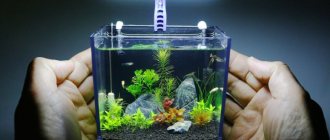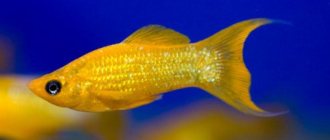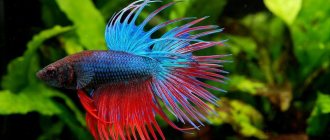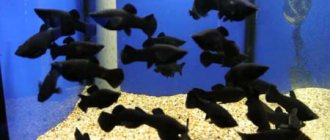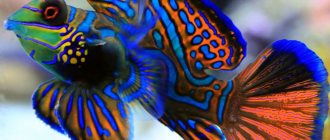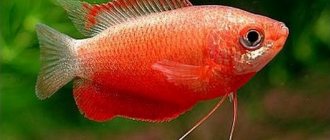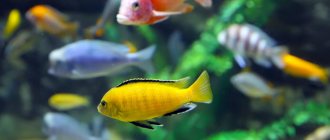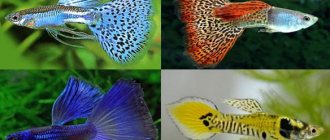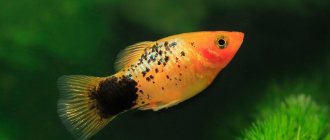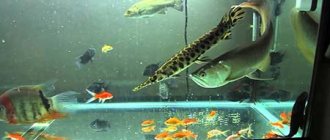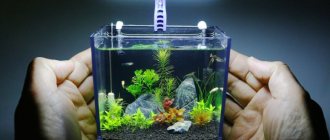Those who dream of the first aquarium in their life usually imagine a 20-25 liter tank. Beginners think that this is the optimal size in which they can easily create their own underwater world. There are those who, for some reason, really can’t afford to have a large aquarium at home. Sometimes unpretentious aquarium fish are vitally needed. And there are also aquarists whose goal is to maintain a nano aquarium with small fish. All this is quite real. In pet stores you can find aquariums for beginners, unpretentious fish for a small aquarium, and even special devices for creating a truly correct biotope.
Small home aquarium: rules
Even small fish require attention and careful treatment. It is more difficult to create good conditions in a 10 liter aquarium than in a 100 liter tank. Useful information for a beginner - basic requirements for a home aquarium:
- Pure water. There should be no objects in the water that release harmful substances into the water.
- Compliance with parameters. Even the smallest aquarium fish cannot live in very alkaline or overly acidic environments, high in chlorine or nitrates. Hardness, acidity - all this will have to be checked regularly.
- Compliance with fish requirements. If the fish needs soil at the bottom, it should be there. If the fish does not need aeration, then the beginner is lucky and there is no need to install a compressor.
- At least minimal care. Like any animal, fish for a small aquarium will still require attention from you: for example, regular water changes.
- It is especially difficult to maintain temperature in small aquariums. You will have to carefully monitor the water temperature.
- It is equally important to ensure that there is no overcrowding in the nano aquarium. Compatibility is the most important parameter when choosing.
Plants
Choose slow-growing plants. If there is good lighting, specialized soil containing organic matter, and a carbon dioxide supply system, plant in the soil:
If the lamp is built into the lid of a small aquarium, the lighting may not be sufficient for some plants. Also make sure that the water parameters are suitable for aquarium greens. In low to moderate light the following survive:
Small fish for the aquarium: top 10 popular species
- Sumatran barbs. Live, active fish that need strong currents. Therefore, when setting up an aquarium, it is important not to forget about the filter that this current will create. Good conditions - an aquarium of 30 liters per flock. It would be better if the aquarium was larger. Barbs feel better in cool water; this is very difficult to organize in mini-aquariums.
- Catfish Corydoras (speckled). Small, unpretentious fish that live mainly on the bottom. They do not need additional air, since they have “gut respiration” and do not only breathe through their gills. Peaceful, calm and positive fish that will become good neighbors to other representatives in an aquarium with a volume of 30 liters or more.
- Platies are creatures that are quite tolerant of poor conditions. Unlike colored fish, guppies have a restrained color scheme and a somewhat combative disposition. They easily fit into aquariums from 30 liters, but they prefer larger tanks. If there is overpopulation, they can start a war. Often in small aquariums they coexist with small catfish.
- Lemon tetra. Grows up to 4 cm, loves a flock of its own kind. Undemanding to conditions and easy to care for and maintain. Bright, and with the right lighting it becomes irresistible.
- Gourami and lalius. They are labyrinthine, which means they have a special breathing system that allows them to do without aeration. For small aquariums this is very important, since it can be very difficult to place a compressor in 20-30 liters.
- Guppy. Perhaps the most popular fish, which is known not only to beginners, but also to people who are generally far from aquarium hobby. Male guppies are brightly colored, with lush fins. Females are larger, but less attractive. Guppies are peaceful and viviparous; under good conditions they can reproduce spontaneously. The optimal volume is at least 20 liters for 5-6 fish. They have an accommodating character, but in a close group they can become unattractive and often get sick.
Interesting fact: despite the fact that we tend to take guppies lightly, there are true connoisseurs of this species. They strive to have rare and unique breeds and spend considerable sums on this.
- Cardinal. Like guppies, male cardinals are brighter than females, but in principle, fish of both sexes look good in a small aquarium. They need a flock of their own kind - at least 12-15 pieces. Calm and cheerful fish that reproduce successfully given suitable conditions. The aquarium for such a flock should be from 40 liters.
- Iriaterina Werner. A fish up to 6 cm in size, with large beautiful fins. Requires an aquarium of 30 liters for 2-3 pieces. Very demanding on water parameters.
- Notobranchius Rachova. The males of these fish are incredibly bright orange-blue. For one family of 2 fish, a capacity of 20-25 liters is enough. But they are demanding on parameters and temperature (they prefer cool water).
Decor
You can also decorate mini aquariums tastefully. Styles suitable even for 10 liter containers:
Pets of rich colors look advantageous against a dark background, and dim fish in herbals. Think about the design of a small aquarium and look at examples in advance. If your 10-liter pond is in the nursery, you can put a toy castle and glow-in-the-dark pebbles. If the tank is in the living room or office, decorate it more discreetly.
Fish for nano aquariums
Nano aquariums include tanks of 4 liters, 5 liters and up to 10 liters. In themselves, such home aquariums are very convenient: they become a desktop decoration along with family photographs and stationery. But in order for the fish to live happily ever after, the microaquarium must be taken care of especially carefully.
- Cockerels. It is believed that this bright fish with lush fins and amazingly beautiful color can live in a glass of water. Of course, this is a misconception; one individual should have at least 4-5 liters, and optimally 7-10 liters. If you want the fish to be happy, a male betta needs a 30-liter aquarium and 2-3 females. Two males definitely won’t get along in a mini aquarium.
- Neon. One of the smallest fish for an aquarium. In theory, several individuals will be fine even in a volume of 10 liters. But neons can hardly be called unpretentious. They prefer to live in flocks of 10-15 pieces, and for such a number they need a tank of at least 40 liters. In addition, neons, like striped zebrafish, are demanding on water parameters. Neons rarely get along with other fish - they are defenseless.
- Danio. They are similar in size and behavior to neons, but do not need a large flock. Appearance – longitudinal dark stripes on a light background. There are also spotted and red ones. They have a wide temperature range (from 15 to 30 degrees), but like all living aquarium settlers, they do not tolerate sudden changes.
- Micro-assortment. Perhaps the most unpretentious aquarium fish for a small aquarium, they grow up to 2 cm. Only 1 liter of water is required per individual, so a mini-flock can be comfortably placed in a nano-aquarium. They look especially good in aquariums filled with living plants and mosses (aquascape), which is done by nano-aquarium professionals. But a beginner who wants to learn aquascaping can start with a small tank.
- Blue-eyed Norman. If you organize the right lighting, the fish will sparkle with amazing neon shades: this is how the eyes of small fish will glow. The size of each individual is 3-4 cm. Playful, active, they are successfully placed in aquariums of 15-20 liters.
- Tetradon dwarf. A rare fish so far, bred specifically for small containers. For a couple of fish, 10-15 liters is enough. But the tetradon is a rather aggressive fish that can start a war for territory, so if possible, it is better to find a larger container and equip it correctly.
- Tetra amanda. Several fish 2 cm long can live in a tiny aquarium, however, tetra is a schooling fish, so the best option is a 30-40 liter tank and a school of 6 pieces. They require good filtration: the water must be clean.
- Neoheterandria elegans. While a little-known breed, it has a bright brindle color and an unpretentious character. For a couple of fish measuring 2.5-3 cm, 10 liters of water is enough. Good fish for beginners, there is one drawback: they are still difficult to find on sale.
- Tetra elahis. Also a rare little one, up to 2 cm in size. It has a soft blue color with spots in the tail area. Prefers to be kept in a flock. For 3-4 individuals you need an aquarium of 20-30 liters, and a full-fledged comfortable flock of 6-8 fish will require an “apartment” of 30-40 liters.
- Formosa. Very easy to maintain, does not require any special conditions, and an aquarium is suitable from 12 liters. Outwardly it resembles neon, but is somewhat smaller in size.
Scenery
The scenery serves as shelter for the animals. It is important that decorations occupy up to 50% of the height and no more than 25% of the bottom area. Aquarium decorations should not contain any hazardous substances and should have no sharp corners so that small fish cannot get hurt. Wash your decorations before diving. Good fit:
A snag protruding from the water looks natural, but if you have shrimp or crayfish, the animals can escape along it.
What kind of fish to get and how to combine them in small quantities
Aquarium 4-5 liters: it is better to leave without live fish, you can limit yourself to just a beautiful design.
Aquarium 10 liters:
- 1 cockerel;
- 3-4 cardinals
- 4-5 guppies or Endler’s guppies (these are natural individuals, they are even smaller than the ones we are used to, bred by breeders);
- 4-5 neons;
- 4-5 Norman blue-eyes;
- up to 10 microdigestions
It is better not to combine several species in such a tank: the schools will be too small, and the fish will not live happily.
Aquarium 20 liters:
- 1 male cockerel with 2-3 females;
- 12-15 guppies;
- up to 20 zebrafish or neons;
- 5-7 cardinals;
- 10-12 happy neons;
- up to 20 microrasbor.
Can be combined:
- 5 guppies and 5 zebrafish;
- 10 guppies and 2 speckled catfish;
- 7-8 neons and 2 speckled catfish.
30 liter aquarium:
- 4-5 barbs;
- 2-3 apistograms;
- 12-15 cardinals;
- 20-25 neons or zebrafish;
- 2-3 macropods;
- 2-3 Werner's iriaterina;
- 10 analysis
30-40 liters is considered ideal for a beginner. It is convenient to observe the behavior of fish, track diseases and organize feeding.
Other families
Acantophthalmus
Cute fish with a serpentine body up to 10 cm in length. They belong to the loach family. They spend time searching for food among the soil and help in cleaning the aquarium. We recognize it by its yellow-brown color in the form of rings encircling the body. The absence of scales makes acanthophthalmus vulnerable to medicinal drugs. Popular types include kuhl and myers.
How long do fish live in small aquariums?
A pressing question, especially for beginners. Small fish rarely survive beyond the age of 2 years. Just open and read the description of any small fish. It indicates the maximum lifespan in captivity, with proper nutrition, lack of stress and good care. If the conditions are unsuitable, the fish live even shorter. Their condition is negatively affected by:
- Dirty water;
- Overpopulation;
- Wrong food;
- Lack of vital facilities (shelters, living plants, soil, aeration, filter);
- Constant stress;
- Incorrect temperature;
- Infections introduced with dirty equipment or new fish. If someone gets sick in a small aquarium, the infection is likely to spread to all the inhabitants, including catfish.
The smaller the aquarium, the less suitable it is for keeping living creatures. Therefore, nano-aquarium is considered a difficult task. However, small home aquariums of 30 liters are quite suitable for beginners: they can accommodate quite a lot of unpretentious fish, be beautifully decorated and equipped with a filter and compressor. Don’t forget that even a small aquarium requires regular maintenance: cleaning the soil, walls, and water changes.
Selection rules
Unpretentious fish for the aquarium are selected taking into account the following characteristics:
- Compatibility of temperaments. Look at the habits of a certain type so that conflicts do not arise.
- Required conditions. For proper settlement, the requirements for the habitat are taken into account. Comfortable temperature, acidity level and water hardness are considered.
- Adult size. Having a clear idea of what size the fish will reach will protect you from a common mistake.
- Schooling Most small fish in their natural environment live in schools. For the well-being of pets, several individuals are accommodated.
- Eating Habits The inhabitants of a body of water feed at different levels: those who feed at the surface of the water and those who obtain food from the bottom. An ill-conceived nutrition system has a detrimental effect on the health of pets.
